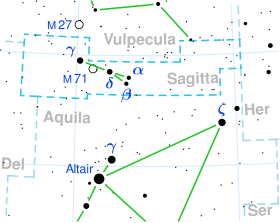| Observation data Epoch J2000.0 Equinox J2000.0 | |
|---|---|
| Constellation | Sagitta |
| Right ascension | 19h 57m 45.44547s [1] |
| Declination | +16° 47′ 20.9781″ [1] |
| Apparent magnitude (V) | 5.53 [2] |
| Characteristics | |
| Spectral type | B9III [3] |
| Astrometry | |
| Radial velocity (Rv) | −26.10±1.6 [4] km/s |
| Proper motion (μ) | RA: 11.609 [1] mas/yr Dec.: 18.605 [1] mas/yr |
| Parallax (π) | 7.5596±0.0600 mas [1] |
| Distance | 431 ± 3 ly (132 ± 1 pc) |
| Details | |
| Mass | 2.47 [2] M☉ |
| Radius | 4.02 [2] R☉ |
| Luminosity | 127 [2] L☉ |
| Surface gravity (log g) | 3.62 [2] cgs |
| Temperature | 9,661 [2] K |
| Metallicity [Fe/H] | 0.0 [5] dex |
| Rotational velocity (v sin i) | 34 [6] km/s |
| Age | 242 [5] Myr |
| Other designations | |
| Database references | |
| SIMBAD | data |
11 Sagittae is a blue giant in the constellation Sagitta with a spectral type of B9III.
